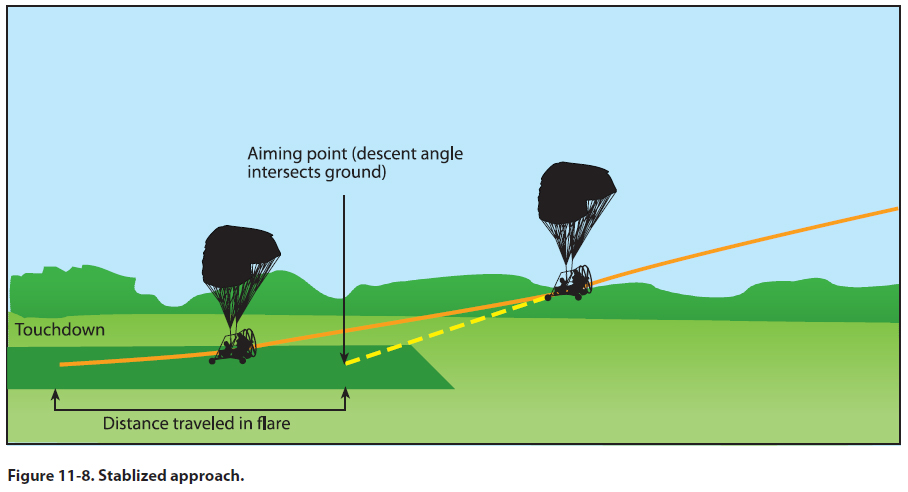|
Chapter 11 — Approaches and Landings
Stabilized Approach Concept
A stabilized approach is one in which the pilot establishes
and maintains a constant angle glidepath towards
a predetermined point on the landing runway.
It is based on the pilot’s judgment of certain visual
clues, and depends on the maintenance of a constant
final approach.
A powered parachute descending on final approach at
a constant rate will be traveling in a straight line toward
a spot on the ground ahead. This spot will not be
the spot on which the powered parachute will touch
down, because some float will inevitably occur during
the powered roundout and flare.
The point toward which the powered parachute is progressing
is termed the “aiming point.” [Figure 11-8]
It is the point on the ground at which, if the powered
parachute maintains a constant glidepath, and was not
rounded out or flared for landing, it would strike the
ground. To a pilot moving straight ahead toward an
object, it appears to be stationary. It does not “move.”
This is how the aiming point can be distinguished—it
does not move. However, objects in front of and beyond
the aiming point do appear to move as the dis-tance is closed, and they appear to move in opposite directions. During instruction in landings, one of the
most important skills a student pilot must acquire is
how to use visual cues to accurately determine the true
aiming point from any distance out on final approach.
From this, the pilot will not only be able to determine
if the glidepath will result in an undershoot or overshoot,
but, taking into account float during roundout,
the pilot will be able to predict the touchdown point
to within a very few feet.

For a constant angle glidepath, the distance between
the horizon and the aiming point will remain constant.
If a final approach descent has been established but
the distance between the perceived aiming point and
the horizon appears to increase (aiming point moving
down away from the horizon), then the true aiming
point, and subsequent touchdown point, is farther
down the runway. If the distance between the perceived
aiming point and the horizon decreases (aiming
point moving up toward the horizon), the true
aiming point is closer than perceived.
When the powered parachute is established on final
approach, the shape of the runway image also presents
clues as to what must be done to maintain a stabilized
approach to a safe landing.
The objective of a stabilized approach is to select
an appropriate touchdown point on the runway, and
adjust the glidepath so the true aiming point and the
desired touchdown point basically coincide. Immediately
after rolling out on final approach, you should
adjust the power so the powered parachute is descending
directly toward the aiming point. With the
approach set up in this manner, you will be free to
devote full attention toward outside references. You
should not stare at any one place, but rather scan from
one point to another, such as from the aiming point
to the horizon, to the trees and bushes along the runway,
to an area well short of the runway, and back to
the aiming point. In this way, you will be more apt to
perceive a deviation from the desired glidepath, and
whether or not the powered parachute is proceeding
directly toward the aiming point.
If the aiming point on the runway is not where you
want it, adjust the glidepath. This in turn will move
the aiming point. For instance, if you perceive the
aiming point is short of the desired touchdown point
and will result in an undershoot, increase the engine
power. The power change must be made smoothly.
This will result in a shallower glidepath with the
resultant aiming point moving towards the desired
touchdown point. Conversely, if the aiming point is farther down the runway than the desired touchdown
point and you suspect it will result in an overshoot,
steepen the glidepath by decreasing power.
The closer the powered parachute gets to the runway,
the larger (and possibly more frequent) the required
corrections may become, resulting in an unstabilized
approach.
Common errors in the performance of normal approaches
and landings are:
• Inadequate wind drift correction on the base
leg.
• Overshooting or undershooting the turn onto
final approach resulting in too steep or too
shallow a turn onto final approach.
• Unstabilized approach.
• Focusing too close to the powered parachute
resulting in a too high roundout.
• Focusing too far from the powered parachute
resulting in a too low roundout.
• Flaring the parachute too early before
touchdown.
• Touching down prior to attaining proper landing
attitude.
• Failure to release the flare after touchdown.
|

